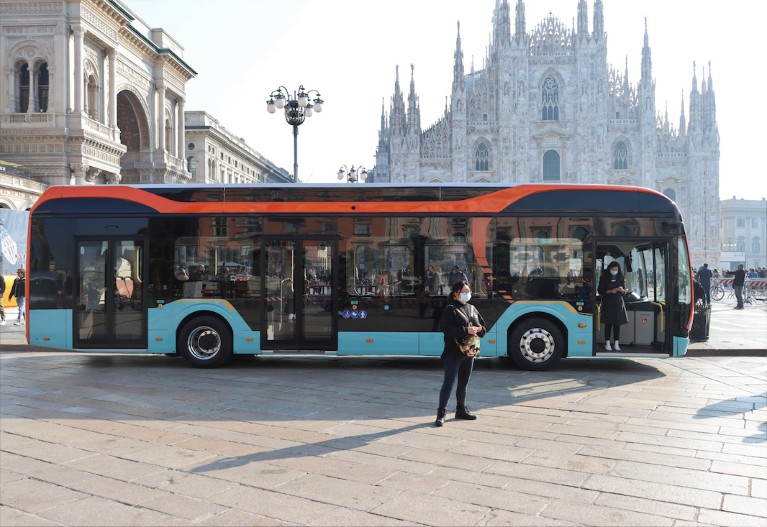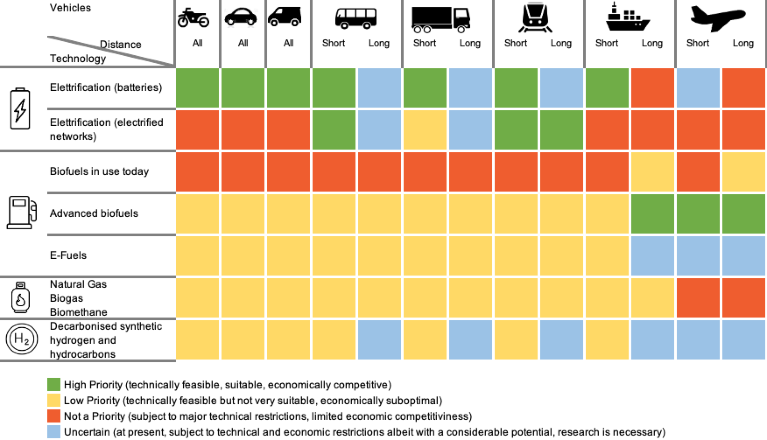
An electric bus in Milan, Italy. Credit: Federico Fermeglia/ iStock Editorial / Getty Images Plus.
Italy’s overall greenhouse gases emissions have been falling during the past 30 years, thanks to a combination of technological change, energy policies and sluggish economic growth. However, the transportation sector is a remarkable exception, with current emissions slightly above 1990 (+3.2%). This raises serious concerns about the feasibility of the goals of the European Green Deal. In order to investigate how the transport sector can be decarbonized, the Minister of Sustainable Infrastructure and Mobility (MIMS) Enrico Giovannini has established a structure of independent experts, named STEMI, to help develop a policy for the ecological transition in these areas.
As members of STEMI, we have prepared a report that, based on the existing scientific literature and on consultation with stakeholders, has looked into the technological options for decarbonization available now and in the foreseeable future, and has identified investment priorities. The key guiding principles were: emission abatement capacity, energy efficiency, cost, and industrial scalability. All major modes of transport were assessed (private cars, commercial vehicles, buses, trains, ships, airplanes).
The solutions based on direct electrification emerge as the most promising technological options for various segments, with strong growth prospects, especially for road transport (Figure 1). They reduce the energy use per km travelled by a factor of 3 or higher, compared to internal-combustion vehicles. Electrification can also reduce environmental impact, in line with the EU climate law on 2030 emission reductions and addressing the chronic Italian air pollution problems. Finally, it improves energy security, which has become a major European priority since the Russian invasion of Ukraine, as shown by the recent RePowerEU plan presented by the European Commission.

The report highlights that for motorcycles, cars, commercial vans and regional heavy duty transport, battery electric vehicles (BEVs) are the most suitable option to meet the 2030 targets, thanks to high energy efficiency, cost-effectiveness and capacity to effectively reduce emissions. Already with the current energy mix, the replacement of the above internal combustion vehicles — which today represent over 99% of Italian road transport — with electric vehicles would lead to a 50% reduction in emissions from light road transport. An even deeper decarbonisation would be obtained by increasing the share of electricity produced from renewable sources. BEVs still have higher purchase costs for small and medium cars, but their total cost of ownership and use (TCO) over the entire life cycle is already equal or lower compared to similar gasoline or diesel vehicles when annual mileage is higher than about 11,000 km. However, it is necessary to strengthen the recharging infrastructure and to develop a domestic sustainable industrial production of batteries, ensuring their second life as stationary storage and end-of-life recycling.
While the technological progress that led to impressive cost reductions for renewables and batteries has made electrification increasingly attractive in transport, technical and cost-related barriers are such that battery technology is not currently viable across all modes. The greatest challenges remain for long-distance and heavy-duty modes. Here, the three main alternatives for electrification are: 1) battery-powered trucks, that need very high-power recharging (1 MW) or battery swap stations; 2) green hydrogen fuel-cell electric trucks; or 3) electric trucks equipped with a smaller battery pack, powered by an overhead line installed on highways. All options need further development and scrutiny involving industrial stakeholders as well as EU and neighbouring countries, in order to converge on common standards that allow mutual interoperability. All options also require high-voltage grid development along the main transport axes, suggesting that planning and deployment need to be prioritized for near-term actions in order to be ready for any future infrastructural decision.
For local public transport, in particular at city-level, battery-powered vehicles represent the best choice in terms of infrastructure, pollution and emissions reduction. For extra-urban transport, extended-range battery-powered vehicles compete with hydrogen-fuel-cell vehicles. The latter — more expensive and less energy-efficient — could however represent an opportunity, particularly in the so-called hydrogen valleys, where the production of green hydrogen is already planned for the decarbonization of other hard-to-abate industrial sectors and where hydrogen transport and distribution costs could be minimised.For trains, whenever electrification is not possible for technical or economic reasons, diesel trains could be replaced by battery ones. For lines longer than 200 km between refueling stations, green hydrogen and low-carbon fuels need to complement electrification in electric-hybrid trains.
Ships and planes are the most complex transport means to decarbonize. Electrification is only applicable for very short distances, such as for less than 50 km ferry-boats or — still in development phase — very small regional aircrafts. Longer distances require decarbonised energy carriers, such as sustainable biofuels, hydrogen-based synthetic fuels and, possibly, green hydrogen. While sustainable biofuels are technologically ready but show availability limitations, synthetic fuels are not technologically mature yet.
Significant investments will be necessary in new renewable electricity, transmission and distribution grids, storage and charging infrastructures. Public charging points, and a regulatory framework for easing installation of private ones are needed quickly. For private vehicles, for both passenger and goods, incentives for electric vehicles must be proportionate and socially equitable, with a global eye on energy poverty issues. For commercial vehicles, for both passenger and goods, incentives to electrification should be prioritized to urban activities and vehicles with high-intensity of use, and take into account that electric vehicles are especially competitive for large vehicles fleet. Incentives for road vehicles, even if low-emission, carry the risk of increasing the demand for cars. Thus, they must be designed as part of a well-defined package of integrated measures with the clear objective to achieve a reduction of the current motorization rate, a shift from private road vehicles to railway first (given the high energy efficiency and emission savings of rail transport) and from car to all public transport, cycling, walking and various new forms of micro and shared mobility.
In conclusion, the report shows – consistently with the findings of the latest IPCC Report – that it is now feasible to reduce emissions from the transport sector in compliance with the climate goals, with positive effects for the environment, public health and the economy. The process will be fully successful only if accompanied by a conversion of the industrial sectors connected to the transport system, currently largely focused on the internal combustion engine and fossil fuels. This entails active labour policies, opening new value chains, promoting circular material practices and introducing social measures to ensure an equitable transition.
